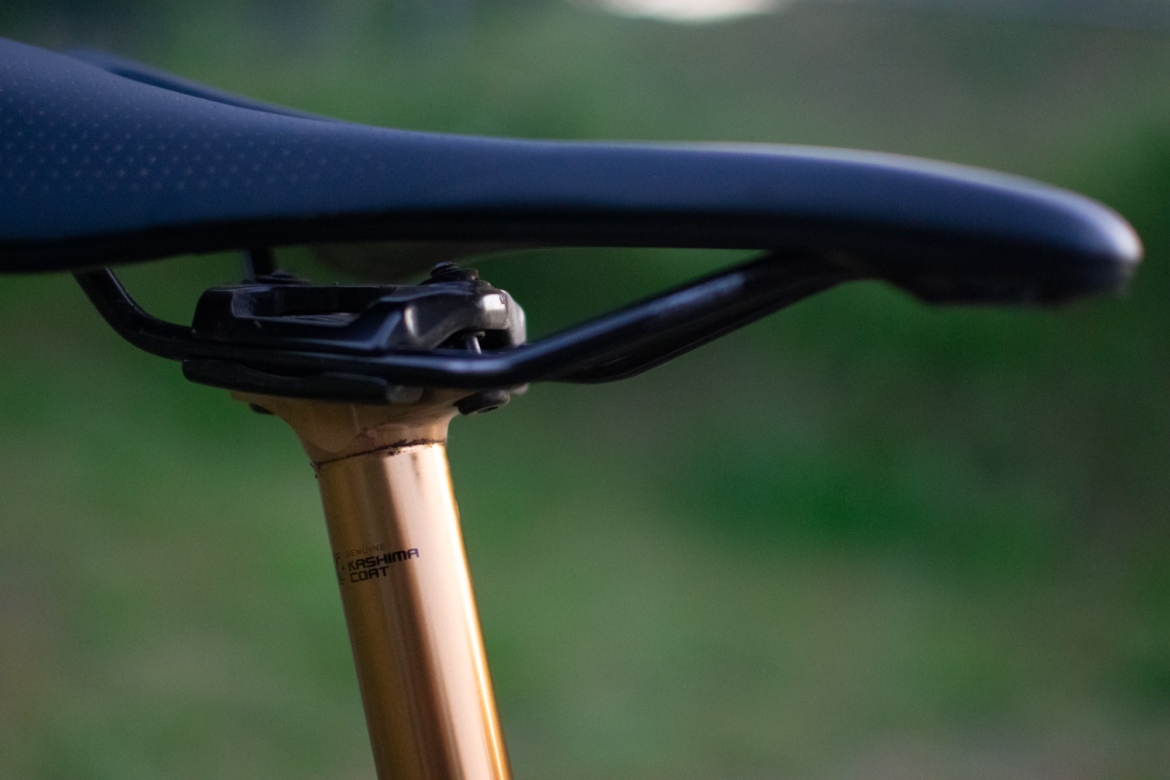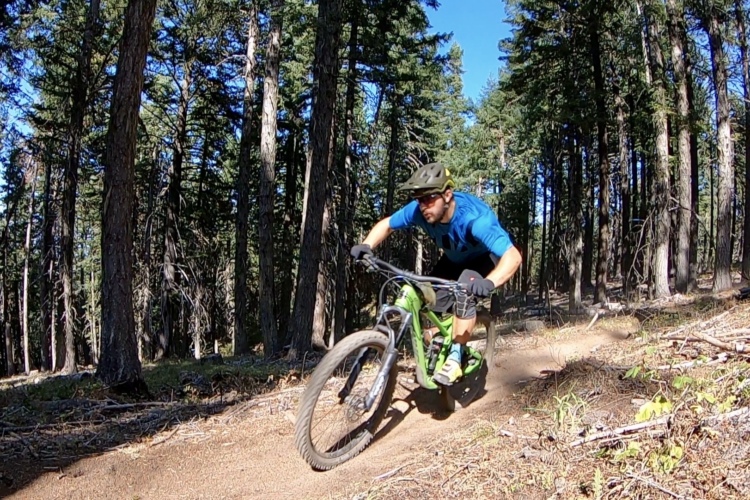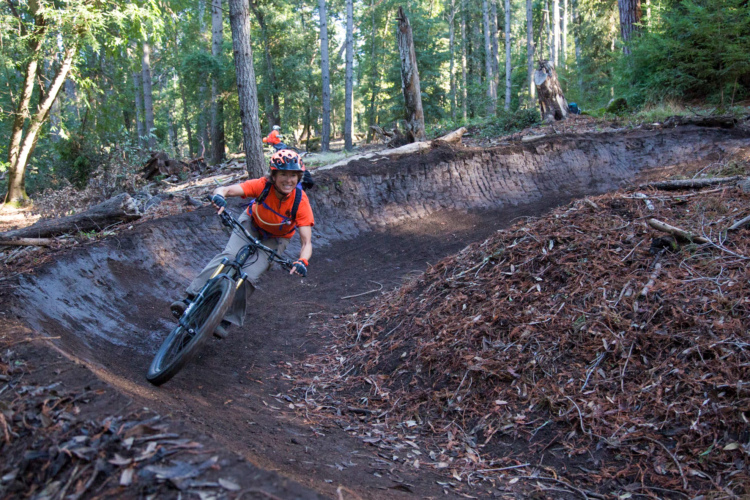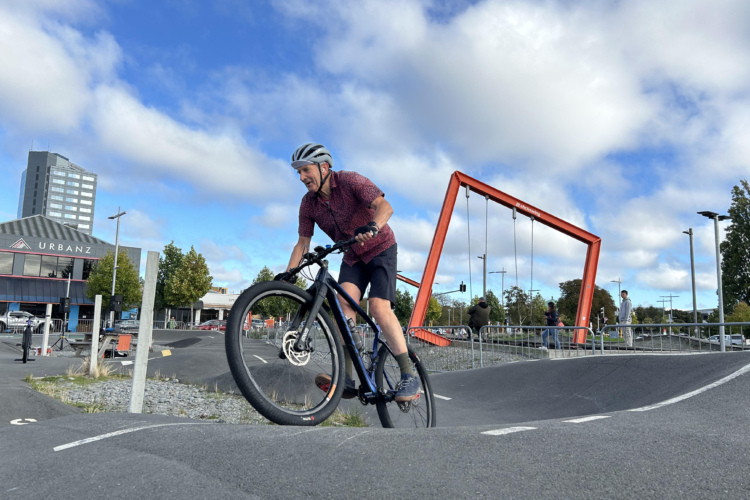
Editor’s note: Unlike most bike reviews Singletracks publishes, this is Sam’s personal bike, which he modified for the BC Bike Race.
The BC Bike Race is one of those bucket-list events for many riders, and had been on mine for a number of years. Finally managing to make it happen for 2024, I scrambled to put a bike together and ultimately chose the Santa Cruz Tallboy 5. BC is renowned worldwide for the technical nature of its trails, and while BCBR is an XC stage race, it does not lack technical trails. Competitors come from across the globe to ride or race here, and bike choice is highly personal, ranging from XC pocket rockets, to full-on enduro sleds.
Knowing that my fitness had taken something of a hit after breaking my ankle in February, I wanted something comfortable that shouldn’t be too jarring on my leg, while remaining pedal friendly, and fun to ride on the way down. After all, I was anticipating I would pass folks on the descents. Plus I wanted to build a bike I could ride at home on Vancouver’s North Shore, and the Santa Cruz Tallboy 5 is about as small as I’d comfortably go for my day-to-day riding around home.
Billed as ‘The downhiller’s XC bike‘, the Tallboy sports 120mm of travel out back and 130mm up front, with a 65.5º head tube angle. I deliberated over a 5010 for a little while before settling on the Tallboy for the shorter travel and dual 29″ wheels.
Santa Cruz Tallboy key specs
- Travel: 130/120mm front/rear
- Geometry highlights: 65.5º head tube angle, 76.8º effective seat tube angle, 475mm reach (size large, tested)
- Price: $5,499 S build (stock)
- Buy from JensonUSA

The Tallboy is a relatively no-nonsense bike in my mind, filling a niche between XC and trail. With a 30lb weight without pedals, it’s not quite ‘downcountry’; I’ll reserve that title for the 25lb Rocky Mountain Element I tested last year. I claimed that bike to be the perfect BCBR bike at the time, and given that Sean Fincham piloted one to the overall win this year, I feel vindicated in that statement. However, I think the Tallboy was the right bike for me this year.
Having ridden the previous generation of Tallboy, I had some idea of what to expect from the bike. The VPP suspension platform delivers a predictable and supple platform, with great pedaling characteristics and a progressive suspension rate that rewards hard charging and late braking.

Frame features
The main frame update for the Santa Cruz Tallboy 5 is in-frame storage, which isn’t a game-changer, though it adds that little extra bit of utility to make grab-and-go riding that much easier. There’s also the addition of tube-in-tube routing on the rear triangle as well as front, the continuation of threaded BBs, a two-position flip chip, Boost hubs, integrated headsets, PM180 brake mounts, 190×45 eyelet shock mounts, frame sizes S-XXL, and two tasteful color options: Gloss White, and Gloss Melon.
Geometry
The Tallboy 5 features a 65.5º head tube angle in low mode, and 65.7º in high mode. Both angles are identical to the older bike, but this time around there’s a steeper seat tube angle at 76.8º. This is likely to make up for the 5mm longer reach, at 475mm in the size large I am riding. Chainstays grow across the range for larger riders, putting the size large here at 437mm, 7mm longer than the previous generation. The BB drop remains the same, with shorter 42mm stems and a wheelbase that is 16mm longer overall. This should make for a more stable, capable, descender without sacrificing too much on the climb.

Build
I ordered the 2024 Tallboy in the S spec with the C-carbon frame, since it represents great value for money, and I intended to run it mostly stock spec. However, I encountered significant scope creep, and wound up swapping every component for what I consider the ultimate ‘BC-spec’ Tallboy build.
Piecing together the build, I opted for some parts that I knew well, and others that would be new to me, putting faith in them to get the job done. Starting out with suspension, I chose a previous generation RockShox B4 Pike Ultimate, for a plusher yet stiffer ride, and bumped it up to 140mm of travel. The B4 Pike has a more forgiving damping platform than the new Charger 3/3.1 dampers fitted to the new C1 forks. I fitted a Rockshox B2 Super Deluxe Ultimate rear shock, which adds piggyback oil capacity for consistent damping on long BC descents, as well as providing a more progressive air spring for bottom-out control than the stock Fox Float DPS shock.


For wheels, I fitted a test set—Industry Nine’s new Solix M Trail 285 aluminum wheelset, with a 24h spoke count and 28mm inner rim width, for a lightweight and hopefully reliable XC/trail wheelset. (Stay tuned for a future review.) I wrapped these in Specialized Fast Trak and Ground Control tire, rear/front, with a Vittoria Air Liner Light, for lightweight, fast rolling grip, with a little additional puncture protection.
For brakes, I wanted something powerful, because the trails here can get fast, steep, and gnarly. I considered my go-to option of SRAM Code RSCs, but decided to try something new, and went with trail/enduro Hope Tech 4 E4 brakes paired with SRAM HS2 200/180mm rotors.
The drivetrain is SRAM X01 Eagle mechanical because cables are reliable and easy to work on—I didn’t want the possibility of failing electronics. I chose to run a 52t cassette and 32t chaining up front fitted to Race Face Era carbon cranks reviewed previously, which are incredibly light for what they are, and still holding up strong for me.




I kept the stock Burgtec stem and added new Race Face Era carbon bars, Wolf Tooth foam Fat Paw grips for comfort, and the Fox Transfer dropper post (in for test) topped off with a Specialized Phenom saddle that I find to be stupid comfortable. For pedals I chose old reliable Shimano XT Trail pedals to minimize the chance of slipping off a pedal and re-injuring the ankle that I broke earlier in the year.
This build came in around 30lb without pedals. Since this isn’t an off-the-peg build, I won’t talk about price.


Climbing
Hopping aboard the Tallboy, climbing immediately feels pleasant. While it’s not a lightning-fast XC whip, it certainly can hold its own, and the first and subsequent rides saw me PR a bunch of my local climbing trails. The Santa Cruz VPP platform is always efficient, and this iteration is no different. A seated pedaling produces little to no suspension bob, and the same can be said for standing; the bike feels very composed, yet delivers grip where it needs to. The not-too-steep seat tube angle puts the rider’s weight roughly where it needs to be for a relatively neutral position, making it feel nimble and quick, but still favoring keeping the front wheel weighted, as trail bikes tend to.
The Tallboy puts power down well, and during BCBR I found myself digging in and hooking up on loose or technical climbs where other riders were breaking traction and having to get off their bikes, though this often required a little weight shift to the rear. Overall, climbing traction is great, and quite predictable. Even square edged hits are absorbed with the appropriate pedal feedback, and there are no strange dead spots as the suspension cycles.

The extra weight of the Tallboy over something lighter no doubt makes a difference, and I tend to feel this in longer road and gravel sections, taking a little more energy to climb at the same pace as a lighter bike. This was evident at BC Bike Race, where I sometimes struggled to keep pace with those on more traditional XC rigs, though this was also likely down to my tire choice as well. However, across mixed and chunky terrain, the Tallboy held its own, and paid off on the descents. On lower angle trails such as day 6 in Campbell River, which wound up being quite a pedally day in flowy singletrack, the Tallboy responded well to the pedally nature of the course, holding speed well the whole day, and being much more pleasant to keep pushing for multiple hours than expected.
One spec choice I wound up changing for Stage 3 of BC Bike Race was the 32t chainring, which proved to be a little big for my legs, and I swapped it for a 30t bailout gear for the bigger days. That was a wise choice, especially for the third stage of the week which had 1500m of climbing across 50km .
Descending
When the trails point downhill, the Tallboy really starts to make sense, and while it’s no slouch on the climbs, descending is where it really comes into its own. Its title as ‘the Downhiller’s XC bike’ rings true, and the geometry and travel numbers all work together to produce a bike that descends much better than expected. Given the geo numbers of the bike, I suspected that under the surface of the Santa Cruz Tallboy hides an excellent descender that could be teased out by a few key upgrades in the suspension and brake departments, and boy was I right.
Set up at 30% sag on the rear, and a little firmer on the front, I typically run this generation of Rockshox fork around 5psi or so over the recommended setting, and tend to max them out on volume tokens to produce the ride quality that I like. The damper isn’t too harsh, so running the suspension firm and progressive suits it well. With 30% sag, the Tallboy feels supple but not overly so, with a good platform to push into, and a decent ramp up at the end which very rarely results in a harsh bottom-out.

The Tallboy is quite honestly one of my favorite bikes in recent memory; the way it combines playful, intuitive handling, stability at speed, and climbing efficiency, means it’s my go-to bike for a lot of different scenarios, and makes it fun almost anywhere. The pedaling efficiency translates not just uphill, but downhill too. Simply stamp on the pedals, and it takes off with ease, translating that effort into speed, and carrying it well, with just enough travel to hold pace through technical sections. On lower angle flow trails, the Tallboy excels; fast, tight trails are its jam, and despite having a longer chainstay than the previous bike, the ease with which I can flick it through ribbons of tight turns at speed is an absolute hoot.
The Tallboy’s stability at speed is impressive too; it begs to be pushed harder both on the ground and off it, and carried me well through some sections of trail at BCBR that I had been a little concerned about leading up to the event. No bother though, the Tallboy takes black and even double-black level trails in stride. The slack head angle and long chainstays make navigating steep and technical sections a breeze. The VPP suspension is laughably predictable, serving up grip in most places, though it rewards late braking, since the suspension does become less active under braking. Learning the limits of the grip of the tires and suspension platform early on allowed me to come to grips with the bike, learning when it would let go, and to let it do its thing. The bike very rarely took me by surprise, with the exception of how well it handled some of the wild lines I pushed through blindly on Vancouver Island.
The Tallboy absorbs chundery sections relatively well for a small bike, though the shortcoming in travel makes itself evident here. Obviously rougher than a bigger bike through chattery sections, the bike does make some rattling noises, likely chainslap. As can also be expected, bigger compressions result in more feedback through the bars and pedals than on a bigger bike, and it gives less margin for error in that regard, and despite being extremely capable, does require a precise hand at times. That said, the Tallboy was the perfect descender for the selection of trails at BC Bike Race, allowing me to make it through the climbs, and really push on in the descents, giving me the edge over smaller XC bikes, which is where I made up most of my time.

Reliability
The Tallboy was an incredibly reliable bike through a week of racing at BC Bike Race. My only gripes are that the Glovebox door is a little loose fitting after a week of racing with an EDC pump and 750ml bottle attached, and the zipper on the tube purse tends to work down slightly and rattles on the inside of the Glovebox door. Aside from that, I was very happy with the frame.
Share your santa cruz tallboy review
The Hope E4 brakes were fantastic, if a little finicky to set up, resulting in a very small amount of rub. For the most part however, I never thought about them, which is exactly what I want to feel about my brakes. They do their job well, with bags of power and modulation, bringing me to a stop in a hurry multiple times throughout the week, and never faltering.
The I9 Solix M Trail 285 wheels were a nice lightweight addition to the bike, feeling stiff and transferring power well. The 0.59º engagement is helpful through technical climbs. Before BCBR however, I had flat spotted the rear rim, making the tape leak. I re-taped the rim hoping it would hold, but after day five it had gone flat again, at which point I fitted my spare Reserve 30 HD wheels. A little disappointed, I’m aware that I’m pushing the envelope for these wheels a little, and given my track record with alloy wheels and the 1.5kg weight, I wasn’t overly surprised. Look for a full review in the future.
The Fox Transfer dropper post performed well for the week, though I sometimes had trouble getting it to top out on the first try every time, sometimes needing a little nudge to get it to full height. Again, look for a full review in the future; I’d like to get a little more time on this one and work out the kinks.
The tires were a bit of a last-minute wildcard over my preference of Vittoria Aggarro tires, but they worked very well. The Specialized T7 compound rolls well and offers good levels of grip, and the combination of Fast Trak and Ground Control tires split the difference between rolling efficiency and predictability through loose terrain. Both get a thumbs up from me.

Final thoughts
Call it confirmation bias, but I’m convinced that I brought the right bike to BCBR for me. Day five in Cumberland was the day that it all clicked for me, with 40km of technical trails over 1250m of climbing, very little of which was easy. I passed riders on climbs and descents alike, and was genuinely just having fun all day. I piloted the Tallboy to my best result of 108th place that day.
Since my training plan went out the window with my broken leg in February, I wanted to build a bike that was above everything else fun to ride, and I achieved that. I have the most fun on the descents, and I wanted the bike to be fast, but reliable and not hold me back there. I came out of the week with a result I’m stoked with—126th out of some 480 riders—and I had as much fun as I possibly could have had. I rarely felt held back on the climbs, and any time I wished I had a smaller bike, I was glad I didn’t when the trail pointed downward.
There are some build elements I might change next time, notably the wheels. Aluminum wheels and I don’t tend to get along, and I tend to have better luck with carbon. This build is a little different to a stock Tallboy build however, and BC riding is different to most other places. While this setup is not going to work for everyone, the Tallboy really benefits from a few upgrades to unlock its full potential for descending capability.
Outside of that, I couldn’t be happier with the way the bike worked for me for the week of BCBR, requiring little more than a chain wipe and lube most days. The Santa Cruz Tallboy blurs a ton of lines and I love it for that. It does things a 120mm travel bike has no business doing, and it might just be my favorite all-round crossover downcountry/trail bike.





















6 Comments
Sep 23, 2024
Jul 26, 2024
Jul 29, 2024
Sep 17, 2024
Sep 17, 2024
Sep 18, 2024